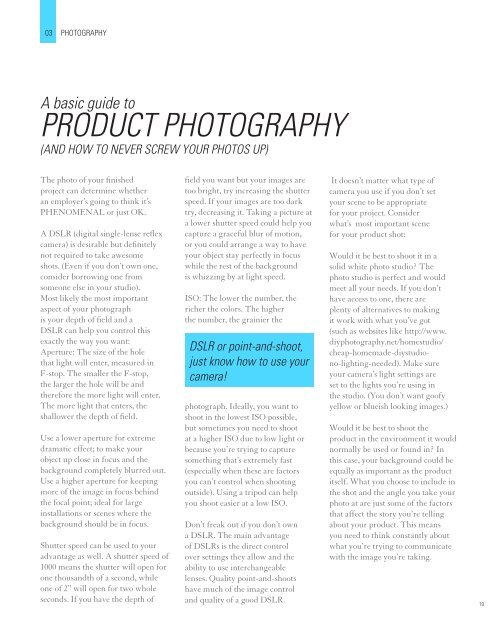HIRE ME?!
HIRE ME?!
HIRE ME?!
Create successful ePaper yourself
Turn your PDF publications into a flip-book with our unique Google optimized e-Paper software.
03 PHOTOGRAPHY<br />
A basic guide to<br />
pRODUCT pHOTOgRApHY<br />
(AND HOW TO NEVER SCREW YOUR pHOTOS Up)<br />
The photo of your finished<br />
project can determine whether<br />
an employer’s going to think it’s<br />
PHENO<strong>ME</strong>NAL or just OK.<br />
A DSLR (digital single-lense reflex<br />
camera) is desirable but definitely<br />
not required to take awesome<br />
shots. (Even if you don’t own one,<br />
consider borrowing one from<br />
someone else in your studio).<br />
Most likely the most important<br />
aspect of your photograph<br />
is your depth of field and a<br />
DSLR can help you control this<br />
exactly the way you want:<br />
Aperture: The size of the hole<br />
that light will enter, measured in<br />
F-stop. The smaller the F-stop,<br />
the larger the hole will be and<br />
therefore the more light will enter.<br />
The more light that enters, the<br />
shallower the depth of field.<br />
Use a lower aperture for extreme<br />
dramatic effect; to make your<br />
object up close in focus and the<br />
background completely blurred out.<br />
Use a higher aperture for keeping<br />
more of the image in focus behind<br />
the focal point; ideal for large<br />
installations or scenes where the<br />
background should be in focus.<br />
Shutter speed can be used to your<br />
advantage as well. A shutter speed of<br />
1000 means the shutter will open for<br />
one thousandth of a second, while<br />
one of 2” will open for two whole<br />
seconds. If you have the depth of<br />
field you want but your images are<br />
too bright, try increasing the shutter<br />
speed. If your images are too dark<br />
try, decreasing it. Taking a picture at<br />
a lower shutter speed could help you<br />
capture a graceful blur of motion,<br />
or you could arrange a way to have<br />
your object stay perfectly in focus<br />
while the rest of the background<br />
is whizzing by at light speed.<br />
ISO: The lower the number, the<br />
richer the colors. The higher<br />
the number, the grainier the<br />
DSLR or point-and-shoot,<br />
just know how to use your<br />
camera!<br />
photograph. Ideally, you want to<br />
shoot in the lowest ISO possible,<br />
but sometimes you need to shoot<br />
at a higher ISO due to low light or<br />
because you’re trying to capture<br />
something that’s extremely fast<br />
(especially when these are factors<br />
you can’t control when shooting<br />
outside). Using a tripod can help<br />
you shoot easier at a low ISO.<br />
Don’t freak out if you don’t own<br />
a DSLR. The main advantage<br />
of DSLRs is the direct control<br />
over settings they allow and the<br />
ability to use interchangeable<br />
lenses. Quality point-and-shoots<br />
have much of the image control<br />
and quality of a good DSLR.<br />
It doesn’t matter what type of<br />
camera you use if you don’t set<br />
your scene to be appropriate<br />
for your project. Consider<br />
what’s most important scene<br />
for your product shot:<br />
Would it be best to shoot it in a<br />
solid white photo studio? The<br />
photo studio is perfect and would<br />
meet all your needs. If you don’t<br />
have access to one, there are<br />
plenty of alternatives to making<br />
it work with what you’ve got<br />
(such as websites like http://www.<br />
diyphotography.net/homestudio/<br />
cheap-homemade-diystudiono-lighting-needed).<br />
Make sure<br />
your camera’s light settings are<br />
set to the lights you’re using in<br />
the studio. (You don’t want goofy<br />
yellow or blueish looking images.)<br />
Would it be best to shoot the<br />
product in the environment it would<br />
normally be used or found in? In<br />
this case, your background could be<br />
equally as important as the product<br />
itself. What you choose to include in<br />
the shot and the angle you take your<br />
photo at are just some of the factors<br />
that affect the story you’re telling<br />
about your product. This means<br />
you need to think constantly about<br />
what you’re trying to communicate<br />
with the image you’re taking.<br />
01 19


